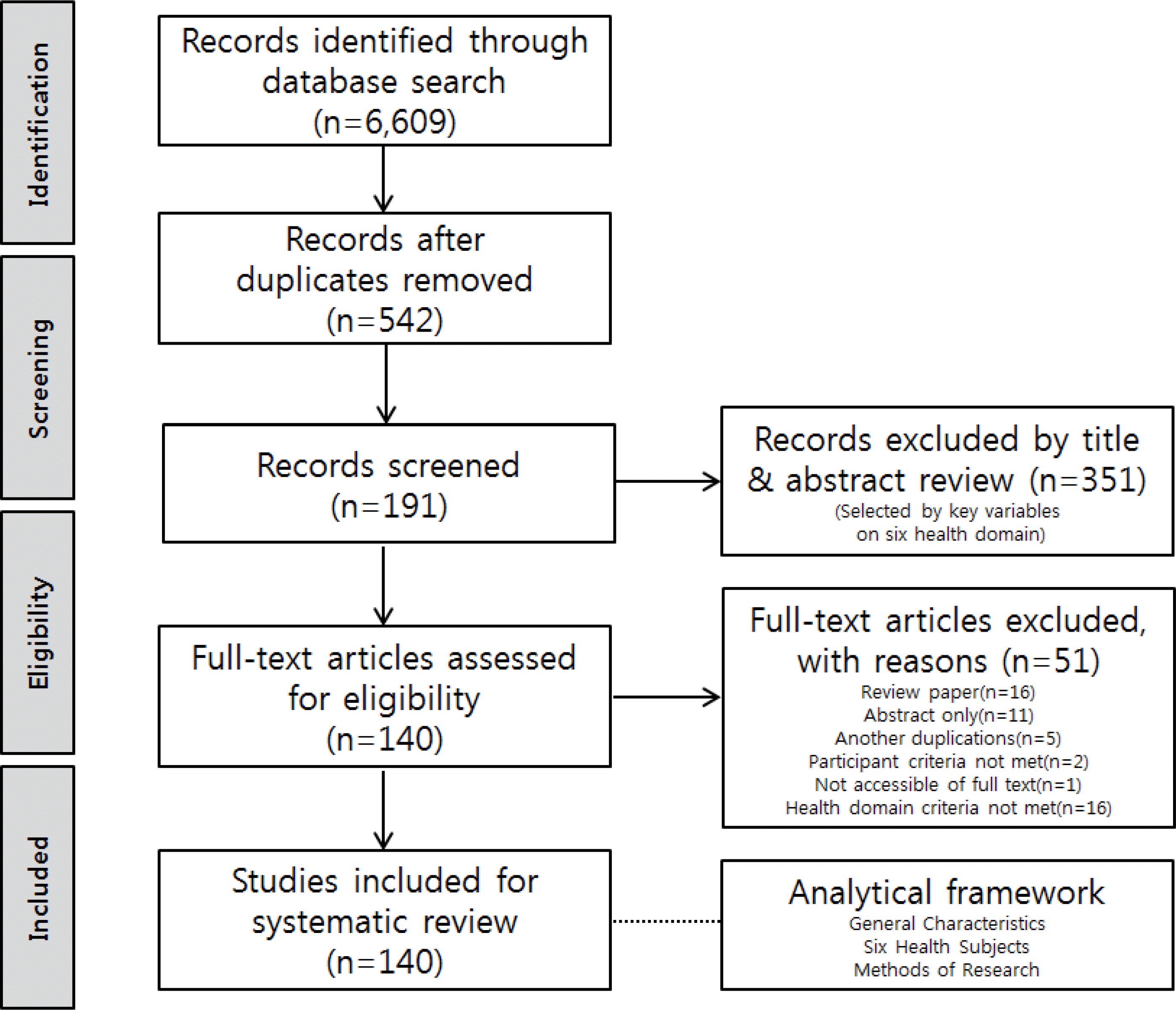1. Ministry of Unification. 2016 North Korean defectors policy [Internet]. Seoul: Ministry of Unification;2016. [cited 2016 May 01]. Available from:. http://www.unikorea.go.kr/content.do?cmsid=3099.
2. Jung JA, Son YC, Lee JH. A Study on defecting motive and social adaptation of North Korean defectors in South Korea: Focusing on moderating effect of resilience. International Journal of Korean Unification Studies. 2013; 22(2):215–248.
3. Ahn DK, Heo JP. Analysis of research trends for studying for North Korea: Focus on Ph.D thesis from 1970 to 2012. The Journal of Peace Studies. 2013; 14(5):143–161. https://doi.org/10.14363/kaps.2013.14.5.143.
4. Kwon HS, Nam MK. Analysis of research trends on North Korean defectors. The Korean Association for Public Administration Winter Conference; 2011 Dec 9-10; Graduate School of Public Administration, Seoul National University. Seoul: The Korean Association for Public Administration;2011. Dec.p. 11.
5. Park KT. Research trends and tasks for the adaptation of North Korean refugees. The Study of Job and Employment Service. 2014; 9(2):15–29.
6. Jeon WT, Yu SE, Eom JS, Kim HJ. 7-Year follow up study of society adaptation of North Korean defectors -With focus given to education and life-. Korean Unification Studies. 2009; 13(1):127–157.
7. Yoon IJ, Kim SK. Health and medical care of North Korean de-fectors in South Korea. Health and Social Science. 2005; 17:149–182.
8. Yoon IJ. Relationships between health and economic adaptation of North Korean migrants. Health and Social Science. 2007; 21:65–96.
9. Ha YS. A study on the support policy and adaptation of North Korean refugees. Korean Political Science Review. 2010; 17(1):125–142.
10. Kim BC, Yu SE. North Korean defectors panel study: Economic adaptation ․ mental health ․ physical health. Panel Study. Seoul: Korea Hana Foundation;2010. May. Report No: 2010-05.
11. Shin HS, Wang YM, Park SC, Ko IG, Jung JG, Ju HM, et al. 2014 survey of North Korean defectors in South Korea. Seoul: Korea Hana Foundation;2014. p. 538.
12. Hong CH, Yoo JJ, Cho YA, Eom JS, Ku HJ, Seo SW, et al. A 3-year follow-up study of posttraumatic stress disorder among North Korean defectors. Journal of The Korean Neuropsychi- atric Association. 2006; 45(1):49–56.
13. Cho YA, Kim YH, You SE. Predictors of mental health among North Korean defectors residing in South Korea over 7 years. Korean Journal of Counseling and Psychotherapy. 2009; 21(1):329–348.
14. Kim YH, Jeon WT, Cho YA. A study on the prevalence and the influencing factors of the mental health problems among recent migrant North Koreans: A focus on 2007 entrants. Unification Policies. 2010; 19(2):141–174.
15. Jeon WT, Eom JS, Min SK. A 7-Year follow-up study on the mental health of North Korean defectors in South Korea. Journal of Traumatic Stress. 2013; 26(1):158–164. https://doi.org/10.1002/jts.21783.

16. Jeon JH, Park YS. The Effects of individual Characteristics and health beliefs on North Korean refugees' health behavior. Journal of Korean Academy of Community Health Nursing. 2012; 23(1):82–90. https://doi.org/10.12799/jkachn.2012.23.1.82.

17. Choe MA, Yi MS, Choi JA, Shin GS. Health knowledge, health promoting behavior and factors influencing health promoting behavior of North Korean defectors in South Korea. Journal of Korean Academy of Nursing. 2012; 42(5):622–631. https://doi.org/10.4040/jkan.2012.42.5.622.

18. Kang YS, Ha YM, Eun Y. Health status and health-promoting lifestyle profile II of North Korean immigrants. Journal of Korean Academy of Community Health Nursing. 2012; 23(3):231–243. https://doi.org/10.12799/jkachn.2012.23.3.231.

19. Lee SH. Current status of medical service utilization by North Korean defectors and tasks in preparation for unification. The World Conference on North Korean Studies. 2015. Oct 13-14; Soongsil University. Seoul: The Korean Association of North Korean Studies; 2015 Oct. 579.
20. Kim JS, Lim JY, Kwon IS, Kim TI, Park HR, Ahn HY, et al. Analysis of research trends in papers published in the Journal of Korean Academy of Child Health Nursing (2005-2009). Journal of Korean Academy of Child Health Nursing. 2011; 17(2):100–110. https://doi.org/10.4094/jkachn.2011.17.2.100.

21. Sohng KY, Kim JI, Choi DW, Kim AK, Chaung SK, Kim KH, et al. Research trends in the Journal of Korean Academy of Fundamental Nursing -Based on analysis of the Journal of Korean Academy of Fundamental Nursing from 2001 to 2007-. Korean Academy of Fundamentals of Nursing. 2008; 15(3):262–273.
22. Choe MA, Kim NC, Kim KM, Kim SJ, Park KS, Byeon YS, et al. Trends in nursing research in Korea: Research trends for studies published from the inaugural issue to 2010 in the Journal of Korean Academy of Nursing and the Journals Published by member societies under Korean Academy of Nursing Science. Journal of Korean Academy of Nursing. 2014; 44(5):484–494. https://doi.org/10.4040/jkan.2014.44.5.484.

23. Kim KH, Kim JH, Lim KC, Lee KS, Jeong JS, Choe MA, et al. Quality assessment tools and reporting standards in nursing research. Journal Korean Society of Biological Nursing Science. 2012; 14(3):221–230. https://doi.org/10.7586/jkbns.2012.14.3.221.

24. Mantzoukas, S. The research evidence published in high impact nursing journals between 2000 and 2006: A quantitative content analysis. International Journal of Nursing Studies. 2009; 46(4):479–489. https://doi.org/10.1016/j.ijnurstu.2008.12.016.

25. Terwee CB, Bot SD, de Boer MR, van der Windt DA, Knol DL, Dekker J, et al. Quality criteria were proposed for measurement properties of health status questionnaires. Journal of clinical epidemiology. 2007; 60(1):34–42. https://doi.org/10.1016/j.jclinepi.2006.03.012.

26. Moher D, Liberati A, Tetzlaff J, Altman DG. PRISMA Group. Preferred reporting items for systematic reviews and meta- analyses: The PRISMA statement. International Journal of Surgery. 2010; 8(5):336–341. https://doi.org/10.1016/j.ijsu.2010.02.007.
27. Lincoln Y, Guba EG. Naturalistic inquiry (Vol. 75). Beverly Hills, CA: SAGE;1985. p. 416.
28. Eileen T, Joan KM. Qualitative rigor or research validity in qualitative research. Journal for Specialists in Pediatric Nursing. 2011; 16(2):151–155. https://doi.org/10.1111/j.1744-6155.2011.00283.x.
29. Mats A, Kaj S. Reflexive methodology: New vistas for qualitative research. London: SAGE;2009. p. 319.
30. Lee YS, Gu HW, Han IY. Systematic reviews of North Korean refugees: Women's distinguishable experience. The Korean Journal of Unification Affairs. 2011; 23(2):147–194.




 PDF
PDF ePub
ePub Citation
Citation Print
Print



 XML Download
XML Download